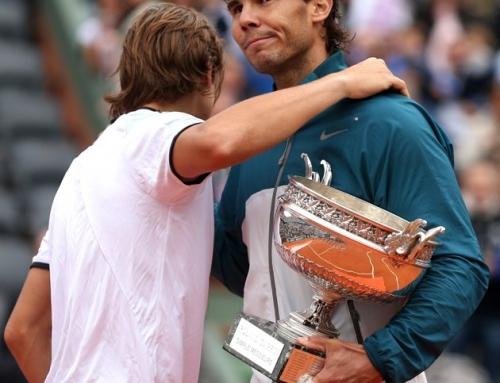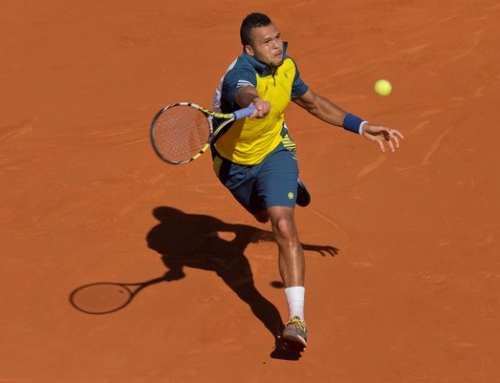When Federer sealed a win over Nadal in Madrid, 6-4, 6-4, a week before the start of the French, there were those that believed this was the year Federer would win the French. He had finally devised a strategy that would negate Nadal’s advantage over him. He would win the elusive title.
Of those who believed Federer could win the French, few, if any, believed Nadal would not be there to meet him.
Nadal had, once again, shown his dominance on clay. He had won Monte Carlo. He had won Rome. He had reached the finals of Madrid. Federer had lost the last three French Open titles to his Spanish rival. Worse still, he had lost to him at Wimbledon in five sets ceding his stranglehold on the manicured lawns of the All England Club. He lost to him tamely in the fifth set of the Australian Open, despite Nadal’s marathon match with fellow Spaniard, Fernando Verdasco, a match many felt would leave Nadal too tired to fight off Federer. In the ceremony, Federer could no longer contain how frustrating it was not to have won. Tears flowed. Nadal held the vanquished, telling him it would be all right.
One wondered if Federer would be able to recover, whether he might not hang it up, and decide his opponent was too mighty, his body too old, his spirit not willing. That feeling may have lasted a day. Federer had, after all, made it to his 19th straight semifinal at a Grand Slam event. He had made short work of Juan Martin del Potro in the quarterfinals. He had defeated rival, Andy Roddick. He still beat most players he played. He was increasingly vulnerable to his top rivals which had come to include Novak Djokovic and Andy Murray.
Then, a miracle, of sorts, happened. Nadal lost. An unheralded Swede, one Robin Soderling, clubbed his way to a four set victory. Nadal looked out of sorts and lost. He cowered many meters behind the baseline. Despite winning a second set tiebreak, Nadal couldn’t hold off the powerful Swede that powered forehands down the line and inside out.
Everyone figured, this would be Roger’s year. He merely had to play like he’s always played. He would win for sure.
But was the pressure too much? Roger had been pushed to four sets by Jose Acasuso, who nearly pushed him to a fifth set. He struggled against Paul-Henri Mathieu, but won in four sets. It’s not that these men played poorly, but that Roger wasn’t playing his usual unbelievable quality of tennis. And when Nadal fell, Roger had to face Tommy Haas.
Haas was one of the few that had beaten Roger Federer, but this was early in Federer’s career, back in 2002. Federer had won a slew of matches against Haas since then. Yet, Haas was hitting well. Despite a first set where Roger won every point on serve, he lost in the first set tiebreak. Haas would then break Roger late in the second set, and it didn’t look good for Roger.
At 3-4 down, Roger would be down 30-40. A serve out wide, a return back to Federer’s ad cour, then a hard hit, inside-out shot an inch inside the sideline. The point seemed innocent enough, but it brought the match back to deuce. It was, as Haas pointed out during the interview, Roger Federer being Roger Federer. Roger would not only go on to win the game, but he would break Haas in the next game, and serve out the third set.
He would then dominate a fourth set taking every single game. Haas would calm himself down in the fifth set and keep the early parts close. It would get to 2-all, but that was as close as it would remain, as Federer broke once and once again, and closed the fourth set comfortably at 6-4.
Next up was France’s last hope. Gael Monfils, who had been a semifinalist, a year earlier, had miraculously worked his way through the draw. His knee had kept him out of most of the clay season. Monfils wanted, it seems, to save himself for his best effort at the French. Federer, on the other hand, had yet to play a really solid match.
Against Monfils, Federer squeaked out the first set, and that seemed to give him confidence. He rolled easily in the second set, 6-2, before the match again got tight in the third set. But Federer had a critical break late in the third set and closed it out against the Frenchman, 6-4 in the third.
At this point, many pointed out, without Nadal in the field, that Federer was 38-1 against everyone else. That one loss came to Fernando Gonzalez in a round-robin year-end Master’s event, one that he won. He has 12 victories to that one loss. He had not lost to Juan Martin del Potro in 5 meetings. This included a straight set win Madrid only a little over a week before the start of the French.
del Potro didn’t start off the clay season that well, but he beat Andy Murray en route. del Potro probably plays better on hard courts than on clay, but his precociousness seems to know no bounds. Prior to the US Open, del Potro won four tournaments in a row, including two minor clay court events and two minor hardcourt events. He buoyed that to a quarterfinal match against Andy Murray, one that seemed destined for a straight set win, but ended up being four sets, and might have gone five had del Potro not looked absolutely fatigued at the end.
del Potro’s ascendancy is not quite as meteoric as Novak Djokovic. Recall 2007. Semifinals at the French. Semifinals at Wimbledon. Finals at the US Open. Were it not for the drama of Federer vs. Nadal, someone might have noticed the loud banging on the door from the scrappy Serb.
Nevertheless, del Potro had used his height, his powerful forehand, and muscle to reach the semifinals of the French Open, dropping only one set, to Jo-Wilfried Tsonga, along the way.
Even so, del Potro hadn’t even taken Federer to a tiebreak set, let alone win a set, in all his losses. Still, when you see a player making great strides, at some point, he starts to make progress.
Federer started off well enough, but then del Potro began threatening nearly every service game, and broke twice to take the first set against Roger, on the strength of powerful attacks on Fed’s second serve. Roger was going to the slice backhand, trying to keep the balls low to the tall Argentine.
The second set was close, but Roger pulled it out in a tiebreak. Usually, once Roger wins a close one, he relaxes and plays very well. The third set didn’t go to script. He got broken once early, and broken once late. 6-2 to del Potro.
Was Federer’s chance to win the French evaporating against the charge of new blood?
Although the fourth set starts out close, Fed manages a break, then a second break, and takes the fourth set, 6-1. The magic appears to be back as del Potro appears to be fading.
Federer opens the fifth with a break of serve, and it looks like he will comfortably ride this to victory. A close game that eventually goes to Federer soon results in a 3-1 lead for Federer. del Potro holds, and then starts attacking Fed, and breaks back to 3-all. This appears like a replay of the Soderling-Gonzalez match where Gonzalez had broken early, but got broken back.
This is where Roger Federer is Roger Federer and not Fernando Gonzalez. He breaks again to 4-3, then holds to 5-3. del Potro then holds to 5-4, but Roger gets to 40-15, and serves it out to win the match.
Roger gets to the final once again. His reward? One hard-hitting Swede. He’s never lost to Robin Soderling, but then Soderling had lost 4 in a row to Gonzalez, and del Potro had never won a set off of Roger.
Here’s hoping to an easy match for Roger in the final, though, some would probably prefer it be competitive. The match will depend on how the first set goes. Roger wins the first set, and it probably goes straight sets. Soderling wins the first, and it could get interesting. At the very least, Roger has had some practice playing tall, hard-hitting players.
Finals on Sunday.
Be there!
NOTE: Nadal has withdrawn from Queen’s club because of his knee injury.




![[French Open] The tactics of the Djokovic-Nadal semifinals](https://www.essentialtennis.com/wp-content/uploads/2013/06/20130607nole-500x383.jpg)
![[French Open, SF] David Ferrer defeats Tsonga in straight sets to reach first Slam final](https://www.essentialtennis.com/wp-content/uploads/2013/06/20130607ferrer-500x383.jpg)
![[French Open, SF] Nadal escapes epic 5-setter with win over Djokovic, to compete for 8th title](https://www.essentialtennis.com/wp-content/uploads/2013/06/20130607rafa-500x383.jpg)
